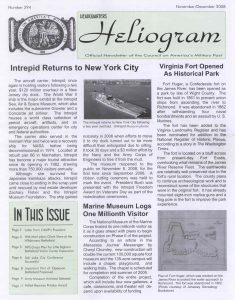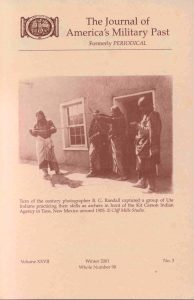CAMP Publications
The Council on America’s Military Past publishes The Journal of America’s Military Past (JAMP), a scholarly publication, the Headquarters Heliogram, an eight-page newsletter, and The Persistent Pandemic Preservationist, a monthly newsletter featuring historic sites across the country responding to the challenges of the COVID-19 Pandemic.
Click on the publication below to see a sample issue. To read The Persistent Pandemic Preservationist, see http://campjamp.org/preservation.
Journal of America’s Military Past Headquarters Heliogram
Headquarters Heliogram
The Headquarters Heliogram is the official newsletter of the Council on America’s Military Past. It provides current information on historic preservation activities from around the world.
Subscription to the Headquarters Heliogram is included in the membership and cannot be ordered separately.
The Journal of America’s Military Past
Formerly Periodical
The Journal is CAMP’s official journal and forum for articles on historical installations and military biography. This fully illustrated and footnoted publication contains in-depth monographs on military history.
 NEW: Now available for download are a listing of articles from Vol. 1 to date and an index of authors and subjects. Click on the links below for each.
NEW: Now available for download are a listing of articles from Vol. 1 to date and an index of authors and subjects. Click on the links below for each.
Article List Author Index Subject Index
Authors Wanted
The Journal of America’s Military Past welcomes new authors, especially graduate students or first-time authors and we are always in search of volunteers to write book reviews. You do not have to be a member of CAMP to write for us. Potential authors should contact the editor to learn more about the Journal format and style. The editor can be contacted by sending an email to EditorJamp@gmail.com.
Current Issue Articles
David Page begins this issue by giving us an essay, “Not Lord Nelson: Watson Smith’s Attack of Fort Pemberton,” discussing the Union army’s combined arms attack on Fort Pemberton during the Civil War’s Vicksburg Campaign. The fort was created to defend the river and survives today along the Tallahatchie River.
The United States entry into World War I necessitated medical support systems in Europe and the U.S. to help with the soldiers injured in the war. “Corpus Christi’s U.S. Army Hospital No. 15, 1918-1919,” by Sanders Marble, examines one of the many institutions the government established to take care of such soldiers.
“Finding its place in a Cold War: North Dakota’s Emergence as Americas Nuclear Frontline,” by Robert Branting, discusses the development of Strategic Air Command’s strategy in the early years of the Cold War. American concern about missile attacks required the Strategic Air Command to develop strategies to counter the Soviet nuclear threat.
Missile bases in North Dakota became an important part of the defense plan.
Additionally, there is the Post Library with thirty book reviews for your enjoyment. As usual, we encourage you to give us feedback on this issue.
Books Available for Review by CAMP Members
The Journal of America’s Military Past has a robust book review section. We aim to review books of general interest to our members, which means that we focus on American military history and give some preference to books that address historic preservation in some way, or the lives of men and women who served at historic posts, which we take to include ships and airplanes. Taking the Battle of Little Big Horn as an example, we would welcome biographies of the men who fought on both sides, and on the ways in which the battlefield has been preserved and interpreted. We never say never, but can say we would be less inclined to review books that addressed, say, battlefield tactics or logistics.
Council on America’s Military Past-USA, Inc.
502 N. Norwood Street
Arlington, VA 22203-2217
